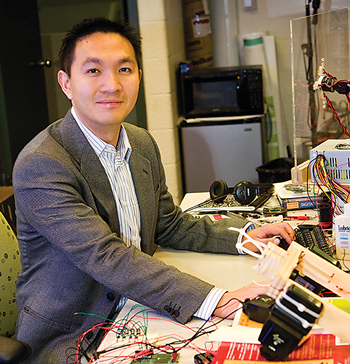Coming up: Naked-eye 3-D TV

OUR FACULTY | For years, the notion of realistic 3-D television has been a potential success story—but one that’s still searching for a practical solution.
Consumers are eager to experience it, and manufacturers are willing to fulfill those hopes, but so far, no one has quite delivered on the technology’s promise.
Jingyi Yu believes he has the answer to everyone’s high-tech-loving, couch-potato dreams.
Since 2003, the jointly appointed UD associate professor (computer and information sciences/electrical and computer engineering) has been dreaming of inventing the ideal 3-D technology—one that makes it more practical for producers to create quality content, and also more convenient for viewers to experience its maximum effect without the need for clunky 3-D glasses.
Now, he’s so sure he has the solution to “naked-eye 3-D TV” that he has taken a leave of absence from UD, launched his own startup company in California, and begun the daunting task of finding the financial and manufacturing partners needed to bring his revolutionary technology to market.
In current state-of-the-art technology, quality “naked-eye” 3-D images require up to 28 cameras in order to capture many views simultaneously, a cumbersome and data-hogging process. Yu’s innovation is to capture those 28 viewpoints—and the capability to manipulate those many perspectives—by using a single camera stuffed with his patented lens devices and algorithms.
In more academic terms, his innovation is called “multi-perspective-view content acquisition using a computational autostereoscopic lightfield camera,” and Yu believes it’s just what the industry needs to easily create content and also translate it into convenient viewing. “There will be a huge market,” not only in the television and movie industries, but in virtual-reality applications, from 3-D conferences to surgical training, he says.
He’s not yet sure when that might happen—this spring, he hadn’t even finalized his company’s name—but he’s quite confident his invention has the potential to be market-changing (and potentially very profitable).
“I’m excited. I’ve been working a lot. I’m literally tripling my work,” he says. “I did not realize a startup would take so much time. I work 12 hours a day or more, seven days a week. But I think it’s worth trying it.”


